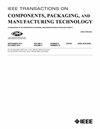Advanced Polymer Dry Etching Processes for Enhanced Cu/Polymer Hybrid Bonding
IF 3
3区 工程技术
Q2 ENGINEERING, ELECTRICAL & ELECTRONIC
IEEE Transactions on Components, Packaging and Manufacturing Technology
Pub Date : 2025-06-30
DOI:10.1109/TCPMT.2025.3584053
引用次数: 0
Abstract
As semiconductor devices continue to demand higher performance and density, Cu/polymer hybrid structures have gained significant attention due to their potential to replace conventional SiO2 dielectrics. In this study, we explore the optimization of dry etching processes for 1,3,5-trimethyl-1,3,5-trivinyl cyclotrisiloxane (p用于增强铜/聚合物杂化键合的先进聚合物干蚀刻工艺
随着半导体器件不断要求更高的性能和密度,Cu/聚合物混合结构由于其取代传统SiO2介电材料的潜力而受到了极大的关注。在本研究中,我们探索了用于铜/聚合物杂化结构的低介电常数聚合物($k =2.2$) 1,3,5-三甲基-1,3,5-三乙烯基环三硅氧烷(p $\text {V}_{{3}}\text {D}_{{3}}$)的干刻蚀工艺优化。采用高纯度化学气相沉积(iCVD)法制备了厚度为200 nm的p $\text {V}_{{3}}\text {D}_{{3}}$薄膜。采用O2、CF4和Ar等不同混合气体进行干燥刻蚀,以评价最佳刻蚀条件。结果表明,在O2/Ar混合气体中,各向异性蚀刻效果最好,蚀刻深度为200 nm,侧壁接近垂直;利用吉布斯自由能计算和x射线光电子能谱(XPS)对腐蚀机理进行了详细分析。本研究的发现为下一代半导体器件的高密度、高性能铜/聚合物混合结构的制造提供了有价值的见解。
本文章由计算机程序翻译,如有差异,请以英文原文为准。
求助全文
约1分钟内获得全文
求助全文
来源期刊

IEEE Transactions on Components, Packaging and Manufacturing Technology
ENGINEERING, MANUFACTURING-ENGINEERING, ELECTRICAL & ELECTRONIC
CiteScore
4.70
自引率
13.60%
发文量
203
审稿时长
3 months
期刊介绍:
IEEE Transactions on Components, Packaging, and Manufacturing Technology publishes research and application articles on modeling, design, building blocks, technical infrastructure, and analysis underpinning electronic, photonic and MEMS packaging, in addition to new developments in passive components, electrical contacts and connectors, thermal management, and device reliability; as well as the manufacture of electronics parts and assemblies, with broad coverage of design, factory modeling, assembly methods, quality, product robustness, and design-for-environment.
 求助内容:
求助内容: 应助结果提醒方式:
应助结果提醒方式:


